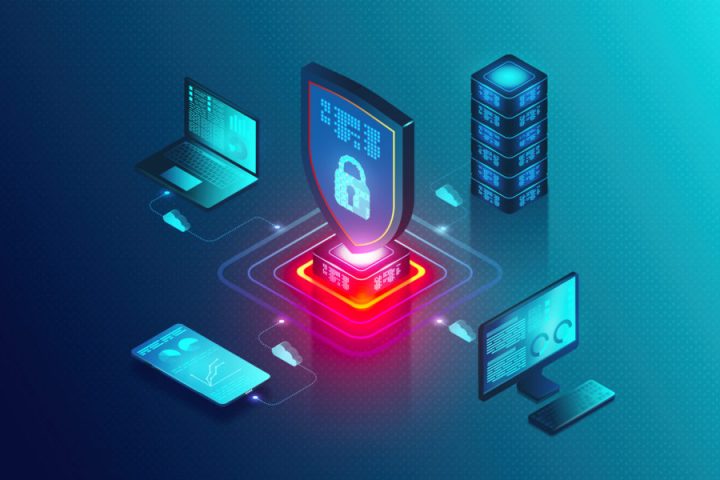The ever-expanding digital footprint of modern organizations comes with new and emerging security threats. Risk management leaders worldwide are working to address sophisticated ransomware, attacks on the digital supply chain, and deeply embedded vulnerabilities.
Most organizations, including small and mid-sized businesses, prioritize the confidentiality of their data and information. Additionally, they provide resources and technologies to work as a defensive barrier against anyone trying to cause trouble.
Threat detection is multifaceted within the context of an organization’s security program. When someone or something slips past the program’s defensive and preventative technologies, it becomes a threat. Therefore, it is important to provide a strategic and comprehensive response process plan.
- Understanding Cyber Threat Detection and Response
- What is Cyber Threat Detection and Response?
- Identifying and Responding to Cyber Threats
- Threat Detection and Prevention VS Threat Detection and Response
- What Are the Different Types of Cybersecurity Threats?
- Three Pillars of Effective Threat Detection
- What are Threat Detection Tools and Technologies?
- Effective Threat Detection and Mitigation Methods
- What is Network Threat Detection?
- Common Threat Detection and Response Challenges
Understanding Cyber Threat Detection and Response

The reality is that cyber threats exist and continue to evolve. These threats extend beyond an organization’s IT network and cloud infrastructures, by causing business disruption, data and monetary losses, and damage to reputation.
A systematic cybersecurity threat detection and response process place companies in a better position to identify threats and proactively minimize and/or avoid their devastating impact.
What is Cyber Threat Detection and Response?
Threat detection is the ability of IT organizations to identify and detect threats to the network, applications, or other security data within the network rapidly and accurately. It can be challenging to recognize malicious network intruders and adversaries almost instantaneously. IT security data analysts have little to no hope of effectively responding to and mitigating security events.
Identifying and Responding to Cyber Threats

There are many cyber threats that can attack your network’s data. Before you can recover from a cyberattack, you need to know what cyber threats exist and if you are at risk. The steps below can ensure the accurate and complete detection of a cyber threat.
Discover All Data on the Network
- Data discovery involves keeping track of the active and inactive assets on a network, including cloud, virtual, and mobile devices. This also includes traditional on-premises workstations and servers.
Scan for Vulnerabilities
- Scanning for and identifying security weaknesses in computer networks and software before they can be exploited.
Analyze and Monitor Network Traffic
- Network traffic analysis (NTA) is a way to monitor network availability and activity to identify security and operational issues.
NTA generally includes:
- Collecting real-time and historical records of what’s happening in the network.
- Detecting malware and vulnerabilities even in terms of protocols.
- Troubleshooting slow networks.
- Improving internal network visibility and eliminating blind spots.
Isolate the Threat
- Email and browser isolation is used to protect users and endpoints frommalware. Users can avoid falling prey to spear phishing, ransomware, and other sophisticated attacks by isolating suspicious links and downloads.
Set Traps
- Baiting infiltrators into strategically placed decoys throughout the network is a cybersecurity defense practice called Deception Technology. After generating a report of the intruder’s actions, security personnel can see what parts of the network are being targeted and can form a predictive defense.
Active Threat Hunting
- Security incidents and threats that have slipped through automated detection methods can still be identified using manual or machine-based techniques. The most successful threat hunting analysts know how to manipulate their tools to find the most dangerous threats.
Threat Detection and Prevention VS Threat Detection and Response
Threat detection is an organization’s ability to monitor events in its IT environment and detect security threats as they happen or, ideally, before they happen.
Threat detection and response is a reactive process that occurs in response to a threat. Therefore, a threat detection and prevention approach security threats proactively by establishing and monitoring systems to detect threats and block the need for threat response.
The goal of threat prevention is the ability to block specific threats before they invade the environment or before they do damage. Cyber threat detection and prevention go hand in hand to prevent a cyberattack. Additionally, you must be able to detect threats as they are happening.
What Are the Different Types of Cybersecurity Threats?

Understanding what threats exist in the cyber environment is foundational as security teams work to build an effective threat detection and response process. Let’s discover the different types of cybersecurity threats.
Malware
- Software programs include spyware, viruses, trojan horse, and other applications that can infect your computer or network and steal sensitive information.
Phishing Attacks
- This tactic uses email or links to pages that have been changed to resemble a familiar site where a visitor may be tricked into volunteering sensitive data such as login information or other personal details.
Ransomware
- A type of malware that locks or disables a computer and asks the user to pay to regain access. Ransomware often begins through email, tricking users into clicking malicious links or opening an attachment that propagates malware into your information technology system.
DDoS Attacks
- These attacks happen when cybercriminals attempt to disable the server by using a network of remotely controlled computers to flood a website or network with traffic.
Blended Threats
- This threat uses multiple techniques to attack a system by simultaneously attacking vectors such as Trojans, worms, and backdoors.
Zero-day Threats
- Also known as zero-hour threats, these are brand new, unpredictable threats that pop up from one day to another, making them especially difficult to prevent.
Advanced Persistent Threat (APT)
- This sophisticated cyberattack includes long-term surveillance and intelligence gathering before attempting to steal sensitive information or target vulnerable systems.
Three Pillars of Effective Threat Detection
Strategy
An effective strategy focuses on long-term planning and identifying broad trends. It can be used to assess an organization’s overall risk potential and formulate strategies for mitigating those risks.
Operations
This is the real-time information that’s most useful for responding to active threats. It can be used to track suspicious movements and take immediate action to prevent an attack.
Tactics
Tactics involve gathering and analyzing information about potential threats to an organization to identify and mitigate them. For example, it is compared to strategic intelligence, but tactical threat intelligence is shorter-term and more actionable.
What are Threat Detection Tools and Technologies?

Network threats and data security are constantly evolving. The threat detection tools, techniques, and technologies to prevent these threats are also changing.
Threat Detection Technologies
Security Event Detection Technology
- Security event technology pulls authentication, network access, and logs from critical systems into one place. Essentially, it brings data together across an organization’s entire network.
Network Threat Technology
- This focuses on monitoring traffic within an organization’s network, between other trusted networks. Additionally, actively scanning for suspicious activities that may indicate the presence of malicious activity.
Endpoint Threat Technology
- This monitoring and collection of endpoint data with rules-based automated response and analysis capabilities are continuous.
Threat Intelligence Tools
Cybersecurity tools are combined into a single environment for business protection by threat intelligence platforms. These tools create the perfect solution for pinpointing issues and eliminating problems immediately. Business leaders will therefore find it simple to identify the complete sources of attacks.
Threat Hunting Tools
These search tools hunt through IT system activity data, looking for signs and indicators of attack or unwanted behavior. The most effective threat hunting occurs when all activity information from all network devices is gathered in one central location. Threat hunters look for, spot, and block malicious activities that can travel between devices.
Effective Threat Detection and Mitigation Methods
All threat detection methods aim to uncover network security data breaches quickly, minimize data loss, and reduce damage with mitigation. Let’s find out more about the different threat detection and mitigation methods available.
Intruder Traps
This technique acts like a sting operation, designed to lure hackers and increase their visibility so cybersecurity teams can detect their presence. Once intruders take the bait, the security system is alerted that someone is actively probing the system, and intervention is needed.
User and Attacker Behavior Analysis
Internal user behavior patterns can be analyzed to help flag deviations that may indicate a user’s credentials have been compromised. This data could include the types of information users access regularly. Some examples are where users work from, and the times of day each user is usually active on the network.
Here is a simple example. A top-level corporate executive typically works regular business hours from home in the U.S. and is unlikely to login to the corporate network at 3:30 am in Europe. Compared to established baselines for normal behavior, this anomaly will quickly be spotted by security analysts and require further investigation.
Threat Intelligence
This is the process of identifying, analyzing, and understanding threats that have previously targeted the organization. Cybercriminals are currently attempting to gain unauthorized access and are likely to do so in the future.
Threat intelligence seeks to understand:
- the methods cybercriminals are using.
- vulnerabilities in the company’s network, systems, and applications.
- the identity of cybercriminals seeking to compromise data networks.
Threat hunting
This proactive approach looks for impending threats or signs that intruders have evaded current cyber defenses and already gained access to key systems. Organization networks, endpoints, and security technology are actively scanned when threat hunting.
What is Network Threat Detection?
Network threat detection is a technology that uses machine learning and behavioral analytics to identify and stop evasive network threats. Security teams do this by monitoring network traffic, developing a baseline of activity, and discovering unusual activity associated with malware, targeted attacks, insider abuse, and risky behavior.
Example of a Network Threat
Computer worms are one of the most common computer network threats. These worms are malware programs that replicate quickly and spread from one computer to another by sending dangerous files to all of the computer’s contacts. Therefore, it also spread immediately to the contacts of other computers.
Common Threat Detection and Response Challenges

With IT organizations moving more data into the cloud, the opportunity to conduct successful cyberattacks has grown exponentially. Data breaches are becoming increasingly common, and cybersecurity professionals face new and ever-evolving challenges.
-
Complex Cloud Environments
The average business uploads up to twenty different applications onto the cloud, making adequate control more challenging.
-
Perimeter Focus
Too much focus on the network’s perimeter leaves vulnerable information within the networks and creates a false sense of security.
-
Infinite Arms Race
It is a constant cat-and-mouse game for IT organizations to develop new threat detection and response capabilities. This is because cyberattacks continue to develop new types of threats to existing systems.
-
Disconnected Tool Suite
A disconnected tool suite with contrasting components can make it difficult and time-consuming to track security events.
-
Staffing Challenges
Cybersecurity job growth is overtaking IT jobs. Additionally, the industry faces a skill shortage when it comes to qualified cybersecurity professionals
How Can Small and Medium-sized Businesses Protect their Network Data?

Cybersecurity and threat detection within an organization are complex. The defense against a security breach is to have a robust security program that is developed and prepared for an unexpected worst-case scenario. Malicious threat actors can bypass even the most advanced defensive and predictive technologies. Therefore, a comprehensive threat detection process is integral to threat detection and response efforts.
Managed Security Service Provider (MSSP)
Cybersecurity is an ever-evolving field tasked with identifying data vulnerabilities with regular assessments, system evaluations, and well-aligned threat detection response actions. Most organizations don’t have the resources, experience, or expertise to handle this essential task.
Fortunately, specialized managed security service providers (MSSPs) offer peace of mind for users and leaders. Security teams, like MSSPs, possess a myriad of tools, processes, and strategies that can help businesses stay as safe as possible. MSSPs can help small and medium-sized businesses save money by avoiding business disruptions. Also, by ensuring compliance with laws governing cybersecurity mandates and other regulations.
Establish Effective Threat Detection and Response with Emeritus
Emeritus can help IT organizations move from reactive IT security to a comprehensive system that proactively shields malicious cyberattacks. With Emeritus, you can improve your cybersecurity status and position across your organization. Our IT experts ensure confident and consistent responses to security incidents.
Our skilled team at Emeritus is the support and resource you can count on for all of your sensitive data needs. Learn more about how we can work with your company to provide exceptional cybersecurity for today’s most sophisticated cyber threats.




